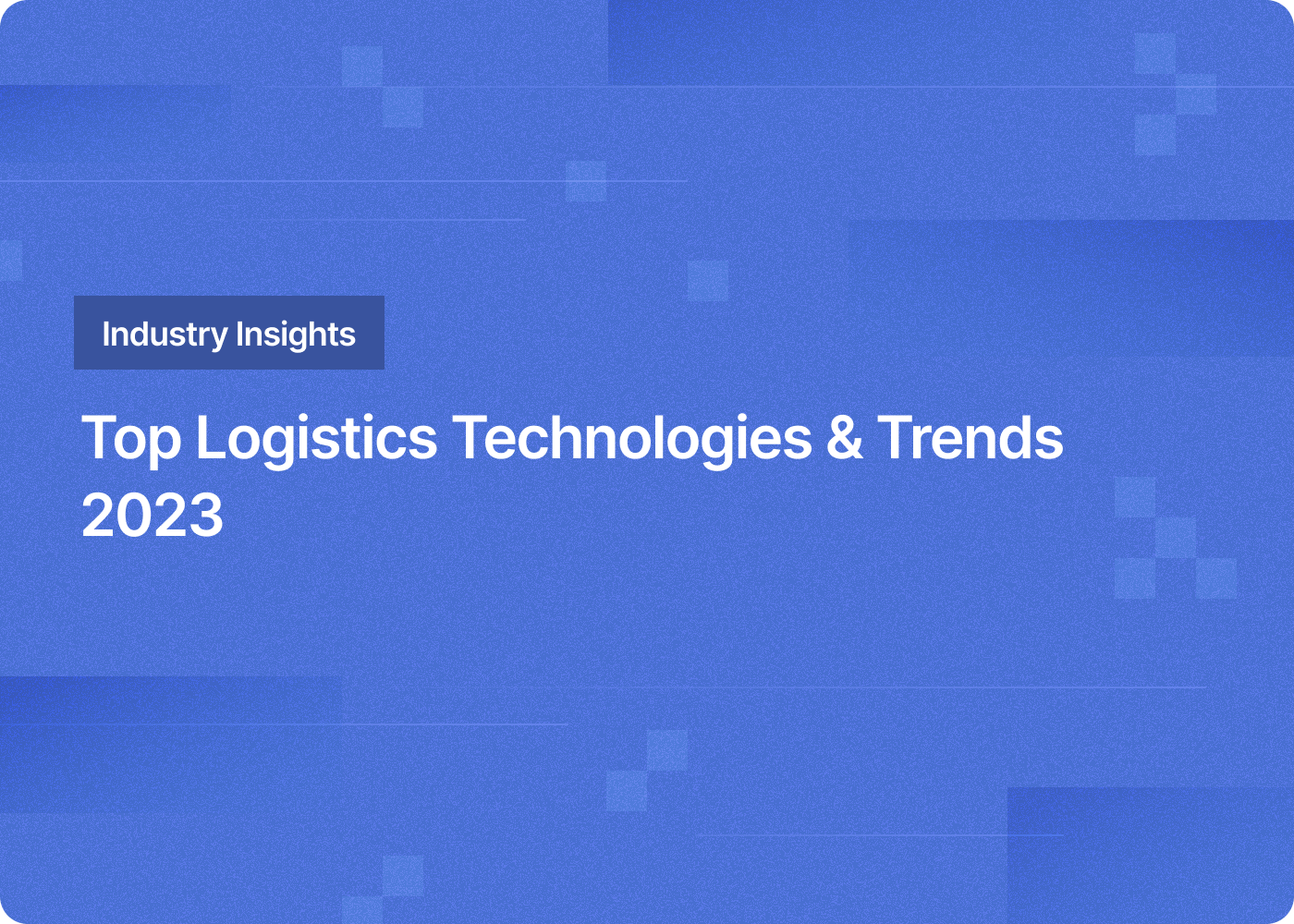In the age of rapid technological advancements, few industries remain untouched by the transformative power of innovation. At the forefront of this digital revolution stands the logistics industry. The dynamism and adaptability of logistics companies are exemplified by their continual integration of cutting-edge logistics technologies into everyday operations.
As the backbone of global commerce, the logistics sector has always been a fast-paced environment. Yet, recent years have seen an unprecedented surge in logistics trends and logistics technology trends that promise to redefine the very essence of supply chain and operations. From artificial intelligence enabling smarter demand forecasting to the Internet of Things (IoT) enhancing supply chain visibility, these are not mere incremental changes; they are foundational shifts setting new standards.
In the paragraphs to come, we’ll delve deep into the tools and technologies modern logistics companies are swiftly adapting. You’ll uncover insights into how these innovations are not only shaping the logistics operations of today but are also paving the way for a future that is smarter, more efficient, and infinitely connected.
The journey we’re about to embark on isn’t just about understanding the technology—it’s about visualizing the future of an industry that keeps the world moving. Whether you’re a stakeholder in the logistics industry, a curious tech enthusiast, or someone keen on understanding the next wave of technological evolution, there’s something in store for everyone. So, let’s set the wheels in motion and explore the future of logistics together.
The Rise of Artificial Intelligence and Machine Learning in the Logistics Industry
The age-old adage, “knowledge is power,” has found renewed resonance in today’s data-driven world. Within the logistics sector, this transformation is significantly marked by the increasing adoption of Artificial Intelligence (AI) and Machine Learning (ML). These twin technologies are not just driving efficiencies; they’re reshaping the very core of how logistics operations function.
How AI is Transforming Logistics Operations:
Predictive Analysis: By assessing vast amounts of historical data, AI aids in accurately predicting future trends, be it in demand forecasting or fleet maintenance schedules.
Route Optimization: With real-time data inputs, AI algorithms can optimize routes, accounting for variables like traffic, weather, and fuel consumption, ensuring timely deliveries and cost savings.
Automated Customer Service: AI-powered chatbots and support systems enhance customer satisfaction by providing instant responses to queries and tracking requests.
Last Mile Delivery: Drones and autonomous vehicles, equipped with AI, are revolutionizing last-mile delivery, ensuring faster and more efficient parcel drop-offs.
Inventory Management: AI helps in analyzing historical data and current trends to optimize inventory, reducing holding costs, and preventing stockouts.
Machine Learning and its Indispensable Role:
Machine Learning, a subset of AI, particularly stands out in the logistics industry for its ability to constantly learn, adapt, and improve. Here’s why ML is the unsung hero in logistics:
Data-Driven Decisions: ML algorithms feed on data. With every piece of new information, these algorithms adapt, enabling logistics companies to make more informed decisions, from warehouse operations to supply chain processes.
Demand Forecasting: By analyzing historical data and current market conditions, ML helps businesses predict future sales and adjust their operations accordingly.
Supply Chain Visibility: Machine learning tools provide insights into every nook and cranny of the supply chain, enhancing transparency and operational efficiency.
Anomaly Detection: Any discrepancies in the supply chain, be it potential fraud or inefficiencies, can be swiftly identified by ML, ensuring smooth and streamlined operations.
As we delve deeper into the digital age, the marriage of logistics operations and advanced technologies like AI and ML promises a future marked by unparalleled efficiency, precision, and growth. For logistics companies willing to embrace these technologies, the sky’s the limit.
Digital Integration: The Synergy of Logistics Technologies
In the dynamic landscape of the 21st century, digital integration stands tall as the bedrock of progress in the logistics industry. As disparate systems coalesce into cohesive networks, the traditional barriers of logistics operations begin to dissolve. Spearheading this transformative shift are innovative technologies like the Internet of Things (IoT), cloud logistics, and digital twins.
The Interconnected World of the Internet of Things (IoT):
IoT is more than just a buzzword; it’s a revolution. Here’s how it’s making waves in the logistics sector:
Real-time Tracking: IoT-enabled devices provide granular tracking of shipments, enhancing supply chain visibility and customer satisfaction.
Smart Warehousing: Sensors and smart devices streamline warehouse operations, automating tasks like inventory management and optimizing product and material storage.
Fleet Management: IoT solutions monitor fuel consumption, fleet maintenance, and other vital metrics, facilitating data-driven decisions and ensuring optimal use of resources.
Enhanced Security: With IoT, logistics providers can monitor the condition of goods in real-time, preventing damage and ensuring the safety of sensitive shipments.
The Cloud Revolution: Logistics Meets Modern Computing
The cloud is not just about data storage; it’s about accessibility, scalability, and flexibility. Its implications for the logistics industry are profound:
Anywhere Access: With cloud logistics, businesses can monitor and manage their operations from any corner of the globe, ensuring continuous oversight and rapid response to changing conditions.
Cost-Effective: Cloud computing minimizes the need for heavy on-premise infrastructure, leading to significant cost savings and reduced operational costs.
Seamless Integration: Cloud platforms effortlessly integrate with other systems, from transportation management systems to advanced analytics tools, streamlining logistics processes and enhancing operational efficiency.
Inventory and Warehouse Management: Real-time data access, facilitated by the cloud, revolutionizes inventory management, allowing businesses to make swift decisions based on current demand and market trends.
Digital Twins: The Game Changer in Logistics Technology
Imagine a virtual replica of your entire supply chain, a digital doppelganger that mirrors every process, product, and pathway. That’s a digital twin. Here’s why they’re the future of logistics:
Predictive Maintenance: By mirroring physical assets in the digital realm, logistics businesses can predict when machinery or equipment might fail, ensuring timely maintenance and reducing downtimes.
Process Optimization: Digital twins offer a sandbox environment, allowing logistics companies to test changes and improvements without impacting the real-world operations.
Data Analytics: These virtual replicas produce a wealth of data, enabling businesses to harness big data analytics, gain insights, and refine their strategies for better outcomes.
Supply Chain Simulation: From assessing the impact of potential disruptions to testing new logistics strategies, digital twins offer a risk-free environment for experimentation and analysis.
The era of digital integration is not on the horizon; it’s here. As logistics technologies evolve, they promise a world where efficiency, transparency, and innovation are not mere aspirations but tangible realities.
The Evolution of Supply Chain Management
As the heartbeat of the global economy, supply chain management has undergone seismic shifts. This evolution is driven by the compelling urge to meet the ever-escalating customer expectations, while ensuring seamless operations from end-to-end. A fusion of modern technologies with time-tested methodologies has rendered the supply chain not just a logistical necessity, but a strategic powerhouse.
Supply Chain Visibility: Seeing the Unseen
Visibility isn’t just about seeing; it’s about understanding, anticipating, and acting. Today’s supply chains necessitate unprecedented clarity:
Holistic Oversight: Advanced technologies enable logistics providers to monitor the entire supply chain, from raw materials to end consumers.
Real-time Monitoring: Enhancing supply chain visibility means instant updates, enabling rapid responses to disruptions or shifts in demand.
Stakeholder Collaboration: Clear insights foster better communication with supply chain partners, ensuring synchronized and streamlined operations.
The Technological Revolution in Supply Chain Operations
While traditional methods still hold value, the integration of advanced technologies is fundamentally changing supply chain operations:
Predictive Analysis: Utilizing historical data and big data analytics, logistics companies can now predict future sales, optimizing inventory management and demand forecasting.
Smart Contracts: These digital agreements, built on blockchain, guarantee transparency and reduce human error, ensuring deals are upheld and automatically executed.
Route Optimization: Advanced analytics tools evaluate numerous factors, from traffic patterns to weather forecasts, to optimize routes and reduce costs.
AI and Machine Learning: By analyzing historical data, these technologies refine supply chain processes, driving operational efficiency and more accurate decision-making.
Warehouse Technology Trends: Merging Old with New
The warehouse, traditionally seen as a static storage space, is now a dynamic hub, pulsating with innovative trends:
Digital Twins in Warehousing: Digital twin technology allows for the simulation of warehouse operations, testing new strategies or layouts before implementation.
IoT in Warehousing: Sensors and interconnected devices streamline warehouse operations, offering real-time data on product location, condition, and stock levels.
Virtual Reality (VR): VR aids in training, helping staff visualize and practice warehouse processes, reducing errors and increasing efficiency.
Hybrid Models: Combining traditional methods with advanced tech, logistics businesses can ensure efficient product and material storage, satisfying both long-standing and newly-emergent customer needs.
At the heart of this evolution is a simple yet profound idea: adapt or perish. As the logistics industry grapples with increasing demands and evolving challenges, the potent blend of tech-driven innovations with foundational principles ensures not just survival, but unparalleled growth and prosperity.
Streamlining Logistics Operations
The dynamic, fast-paced nature of today’s global marketplace necessitates efficiency, agility, and precision in logistics operations. To remain competitive and ensure customer satisfaction, businesses are relentlessly seeking ways to optimize every aspect of their operations, from transportation to warehouse management.
The Strategic Advantage of Streamlining Operations
Streamlining isn’t merely about cutting corners or trimming costs; it’s about realizing a business’s full potential:
Competitive Edge: Streamlined operations give logistics companies a competitive advantage, enabling quicker, more reliable deliveries.
Operational Efficiency: Efficient logistics processes translate to reduced operational costs and wastage, paving the way for better profitability.
Enhanced Customer Satisfaction: As businesses can meet or exceed customer expectations consistently, they cultivate loyalty and foster long-term relationships.
Flexibility: Streamlined logistics operations are more adaptable to sudden changes in the market or unexpected disruptions, ensuring uninterrupted service.
Tools of the Future: Modernizing Logistics
The logistics sector is no stranger to innovation. From cloud computing platforms to AI-driven analysis, tools are evolving:
Route Optimization: Advanced analytics tools utilize real-time data, predicting bottlenecks, traffic, and other impediments to optimize routes, ensuring timely deliveries.
Advanced Shipment Tracking: Modern shipment tracking systems provide granular, real-time updates, increasing supply chain visibility for both businesses and consumers.
Internet of Things (IoT): IoT devices in vehicles and warehouses monitor conditions, track assets, and provide data-driven insights to improve logistics operations.
Predictive Analytics Solutions: Analyzing historical data, these solutions allow logistics businesses to anticipate demands, fine-tune their strategies, and ensure they are always a step ahead.
Transportation Management Systems (TMS): These holistic platforms integrate various logistics functions, from route planning to cost savings analyses, under a single umbrella.
The shift towards streamlined logistics operations is not just a trend; it’s a necessity. As customer expectations rise and the global marketplace becomes even more interconnected, logistics companies that adopt and adapt to these modern tools and strategies will be the ones that stand tall and thrive.
Emerging Tech: Pioneers in the Logistics Sector
In the rapidly evolving world of logistics, innovation is not just welcomed; it’s demanded. The landscape of the logistics sector has been drastically transformed by a wave of emerging technologies. These innovations are not only reshaping operations but also redefining customer expectations and establishing new industry standards.
A Deep Dive into Logistics Technology Trends
From the intricate virtual designs of products to the roads, technology is making its impact felt in every corner of the logistics industry.
Virtual Reality (VR): VR has transcended gaming and found its niche in logistics. From virtual training modules for new employees to 3D warehouse design and simulation, VR provides an immersive experience that facilitates better planning and decision-making.
Autonomous Vehicles: Perhaps one of the most anticipated logistics technology trends, autonomous vehicles promise a future with fewer human errors, reduced costs, and enhanced efficiency. From drones delivering packages to self-driving trucks navigating highways, the future of transportation in the logistics industry is autonomous.
The Smart Way Forward: Revolutionizing Logistics with Smart Contracts
Smart contracts are set to fundamentally reshape how transactions and agreements are made in the logistics sector:
Automated, Trustworthy Transactions: At their core, smart contracts automatically execute and verify transactions once predefined criteria are met. This automation not only speeds up the transaction process but also ensures its accuracy and reliability.
Transparency and Security: Built on blockchain technology, smart contracts offer unparalleled transparency, ensuring all parties have access to the same immutable information. This transparency fosters trust among logistics providers, shippers, and recipients.
Cost-Efficient Operations: By reducing the need for intermediaries and automating many administrative tasks, smart contracts can lead to significant cost savings in logistics operations.
Streamlined Dispute Resolutions: In the rare event of disagreements, smart contracts provide a clear, agreed-upon framework for resolutions, reducing delays and fostering a smoother business environment.
The wave of emerging technologies, from the immersive worlds of VR to the automated highways for autonomous vehicles, combined with the smart, secure, and streamlined possibilities of smart contracts, signifies a bright and innovative future for the logistics sector. These pioneering tools and methods are set to usher in a new era, one characterized by efficiency, security, and uncharted possibilities.



